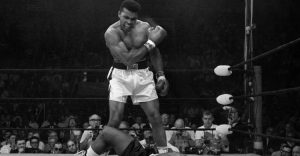
You may be a boxing enthusiast, or at the very least know the career of the legendary Muhammad Ali, so you might think you don’t need to watch Antoine Fuqua’s documentary What’s My Name: Muhammad Ali. But that would be a mistake. Read on to find out more about this unique look into one of the last century’s most famous figures….
WHAT’S MY NAME: MUHAMMAD ALI: STREAM IT OR SKIP IT?
The Gist: Muhammad Ali has been dead for three years now, and he spent the last decades of his extraordinary life slowed by symptoms of Parkinson’s syndrome, a condition that has similar symptoms to Parkinson’s disease, but is brought on by trauma. And during Ali’s quarter-century boxing career, from fighting for the first time as a preteen to his last match when he was 39, he took a heck of a lot of trauma.
What’s My Name: Muhammad Ali, directed by Antoine Fuqua (Training Day), focuses in on Ali’s career over two parts and 220 minutes. You may not thing that Ali’s boxing career needs that much time, but Fuqua proves that it does. The story is told completely via archival photos, TV footage and interviews, mostly longform ones Ali did in the 1970s in the UK, though we saw him with his buddies Dick Cavett and Howard Cosell, as well.
Part one starts with Ali’s birth certificate from Louisville Kentucky, where he was born as Cassius Clay in 1942. We go almost straight into his amateur boxing career, where he won dozens of matches, Golden Gloves, and an Olympic gold in 1960. From there, Fuqua tracks his professional rise through the ranks, culminating in his defeat of Sonny Liston to win the WBA heavyweight title in 1964. At a certain point, Ali went from a talkative but respectful young man to realizing that if he became confrontational, outspoken, poetic and funny, he’d attract a bigger audience, even if they paid to boo him.
Fuqua also documents Ali’s entry into the Black Muslims, following the teachings of that group’s leader, Elijah Muhammad, and Malcolm X. Also, shortly after his first championship victory, he changes his name from Cassius Clay to Muhammad Ali, but it took years for people to respect his wishes and not call him by his birth name. One opponent refused to call him anything but “Cassius Clay,” prompting Ali to yell “What’s my name?” to him not only during the pre-match press conference but in the match as well.
Ali was a civil rights proponent, but he did it his way, speaking out about not being served in his hometown after his gold medal and other stories. But his activism came to the forefront in 1967, when he refused to be inducted into the draft to send young men to battle in Vietnam; his refusal cost him not only his title, but he was under threat of a federal prison term. Almost four years of his prime were taken away, while Joe Frazier rose through the ranks to become heavyweight champion.
Part two takes on Ali’s second phase, when he was reinstated in 1970. This is his elder statesman phase (at the ripe old age of 28!), where he trained in the Pennsylvania woods in a camp he helped build, built his rivalry with Frazier, to whom he lost his first professional match in 1971, developed his rope-a-dope style that he figured would wear out aggressive fighters like Ken Norton and George Forman, and basically became one of the most famous people on the planet.
What Movies Will It Remind You Of?: HBO loves Ali, airing documentaries, from one about the “Thrilla In Manila” against Foreman to the one about his loss in the first of three epic matches against Frazier. This one, however, is more epic in scope and doesn’t have any current interviews, leaving Ali himself to talk about what he went through during all his fights.
Performance Worth Watching: Ali, of course. Fuqua does a fantastic job of showing the breadth of Ali’s experience, and doesn’t just play highlights of him doing his “float like a butterfly” shtick. There are candid interviews where a subdued Ali talks about how much work and effort it takes to get him ready for his matches, how ambivalent he was about boxing, and how he gets nervous before every match.
Our Take: Though we’re not boxing scholars, we know a fair amount about Muhammad Ali’s life and career. But What’s My Name put it all together in such detailed form, that we feel the format gave us more insight into his well-known career than we used to have.
For instance, Ali fought a lot. He averaged about 3 matches per year as a pro, and that includes the 3-plus years he was suspended. Especially in the years during the early ’70s where he was trying to regain his title, he fought tomato cans like Chuck Wepner (whose tough stand against Ali inspired Sylvester Stallone to write Rocky) and up-and-comers like Norton (to whom he lost the first time they fought) a few months apart. And he took pains to point out that he was training and fighting and staying active while opponents like Frazier were waiting for the big paydays and wasting their once-per-year fights on weak opponents.
And the fact that Fuqua took four years to find interview footage of Ali that was less schticky and more honest yielded the fact that Ali, for all his bluster about being “The Greatest,” had serious doubts about himself when he entered the ring, even when he was in his invincible first phase.





